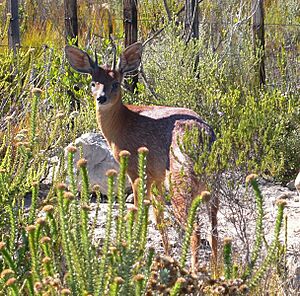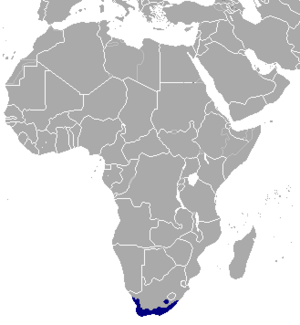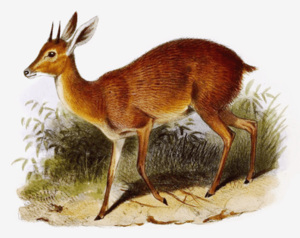Cape grysbok facts for kids
Quick facts for kids Cape grysbok |
|
|---|---|
 |
|
| A ram at De Hoop, Western Cape | |
| Conservation status | |
| Scientific classification | |
| Genus: |
Raphicerus
|
| Species: |
melanotis
|
 |
|
| range | |
The Cape grysbok (scientific name: Raphicerus melanotis) is a small antelope. It lives only in the Western Cape region of South Africa. You can find it between Albany and the Cederberg mountains.
Contents
What Does a Cape Grysbok Look Like?
Cape grysboks have a rough, reddish-sandy coat. It has white flecks all over its body. Their head, neck, and legs are more yellowish and have fewer flecks. The inside of their ears, the rings around their eyes, mouth area, throat, and belly are white.
They have a black "bridge" on their nose. They also have a dark scent gland in front of each eye. These small antelopes stand about 45 to 55 centimeters (18 to 21 inches) tall at the shoulder. They weigh around 8 to 12 kilograms (18 to 26 pounds).
Their tail is very short, only 4 to 8 centimeters (1.5 to 3 inches) long. It is almost impossible to see! Male grysboks have short, sharp, and straight horns. These horns are smooth and about 8 centimeters (3 inches) long. When a Cape grysbok feels scared, it can fluff out the fur on its rear end. This makes it look bigger to scare away danger.
Where Do Cape Grysboks Live?
Cape grysboks live in the "Fynbos biome" of South Africa. This area is also known as the Cape Floristic Region. They prefer to live in thick shrubland. Sometimes, you might spot them near orchards and vineyards. In the Cape Peninsula, they can even be found close to towns and cities. They also live in reed beds and along riverbeds in the southern Karoo region.
How Do Cape Grysboks Behave?
Cape grysboks are usually seen alone. This suggests they might be territorial, meaning they defend their own space. They are browsers, which means they eat leaves, shoots, and fruits. They can go for a long time without drinking water. They get most of the water they need from the plants they eat.
These animals are mostly active at night. However, you might see them in the early morning or late evening during the southern winter. Like their relatives, Sharpe's grysboks, they use a shared toilet area called a latrine. They also mark plants nearby with special smells from glands near their eyes. When they need to defend themselves, they jump forward towards what is bothering them, then quickly run away.
When Do Cape Grysboks Have Babies?
Baby grysboks, called lambs, are born in the southern summer. Their mothers carry them for about 6 months before they are born. The lambs stay hidden after birth and grow very quickly.
Are There Similar Animals?
Yes, there is another similar animal called the Sharpe's grysbok (Raphicerus sharpei). It lives in southeastern Africa. The main way to tell them apart is that Sharpe's grysbok has a pair of "false hooves" above its ankles.
Images for kids




